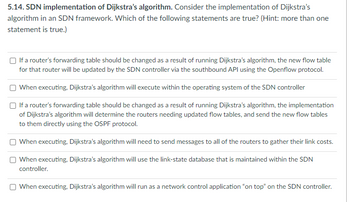Question

Transcribed Image Text:5.14. SDN implementation of Dijkstra's algorithm. Consider the implementation of Dijkstra's
algorithm in an SDN framework. Which of the following statements are true? (Hint: more than one
statement is true.)
If a router's forwarding table should be changed as a result of running Dijkstra's algorithm, the new flow table
for that router will be updated by the SDN controller via the southbound API using the Openflow protocol.
When executing, Dijkstra's algorithm will execute within the operating system of the SDN controller
If a router's forwarding table should be changed as a result of running Dijkstra's algorithm, the implementation
of Dijkstra's algorithm will determine the routers needing updated flow tables, and send the new flow tables
to them directly using the OSPF protocol.
When executing, Dijkstra's algorithm will need to send messages to all of the routers to gather their link costs.
When executing, Dijkstra's algorithm will use the link-state database that is maintained within the SDN
controller.
When executing, Dijkstra's algorithm will run as a network control application "on top" on the SDN controller.
Expert Solution
This question has been solved!
Explore an expertly crafted, step-by-step solution for a thorough understanding of key concepts.
This is a popular solution
Trending nowThis is a popular solution!
Step by stepSolved in 4 steps

Knowledge Booster
Similar questions
- Suppose we have switches S1 through S4; the forwarding-table destinations are the switches themselves. The tables for S2 and S3 are as below, where the next_hop value is specified in neighbor form: S2: ⟨S1,S1⟩ ⟨S3,S3⟩ ⟨S4,S3⟩ S3: ⟨S1,S2⟩ ⟨S2,S2⟩ ⟨S4,S4⟩ From the above we can conclude that S2 must be directly connected to both S1 and S3 as its table lists them as next_hops; similarly, S3 must be directly connected to S2 and S4. (a). The given tables are consistent with the network diagrammed in exercise 6.0. Are the tables also consistent with a network in which S1 and S4 are not directly connected? If so, give such a network; if not, explain why S1 and S4 must be connected. (b). Now suppose S3’s table is changed to the following. Find a network layout consistent with these tables in which S1 and S4 are not directly connected. Do not add additional switches. S3: ⟨S1,S4⟩ ⟨S2,S2⟩ ⟨S4,S4⟩ While the table for S4 is not given, you may assume that forwarding does work correctly.…arrow_forwardConsider both questions pls....arrow_forwardDownload delays for 100 objects (HTTP 1.1 with local web caching). Consider an HTTP 1.1 client and server. The RTT delay between the client and server is 2 seconds. Suppose the time a server needs to transmit an object into its outgoing link is 3 seconds. There is also a local web cache, as shown in the figure below, with negligible (zero) propagation delay and object transmission time. The client makes 100 requests one after the other, waiting for a reply before sending the next request. All requests first go to the cache (which also has a 2.0 sec. RTT delay to the server but zero RTT to the client). How much time elapses between the client transmitting the first request, and the receipt of the last requested object, assuming no use of the IF-MODIFIED-SINCE header line anywhere, and assuming that 50% of the objects requested are "hits" (found) in the local cache? Your answer should be among the following list( 702 secs, 552 secs, 352 secs, 350 secs, 150 secs) . Show your…arrow_forward
- 06. The following vectors have just come in to router C: From B (5, 0, 8, 12, 6, 2); From D: (16, 12, 6, 0, 9, 10); From E: (7, 6, 3, 9, 0, 4) The measured delays to B, D and E are 6,3,5. What is the C's new routing table?arrow_forwardThe figure depicts K sources which are connected to the Internet via links of capacity RS, and within the network fairly share a common link of capacity R to K destinations. Each destination is connected to the network by a link of capacity RD. You can assume that there are no other links or source-destination pairs in the network. Now suppose that source Si has an infinitely large file it wants to send to destination Di (i.e., each source sends to a different destination). a. If K=10, RS = 100 Mbps, Rd=10 Mbps, and R = 10 Gbps. What is thethroughput between each source-destination pair? Where are the bottleneck links? b. If we now assume that K=10, RS = 100 Mbps, Rd= 100 Mbps, and R = 0.5 Gbps. What are the new throughputs between each source-destination pair? Where are the bottle-neck links? c. In scenario b above, suppose we increase the capacity of the destination links to 1 Gbps. Will this increase the throughput between sources and destinations? Briefly (in less than 5 sentences)…arrow_forward6.4-2 Network- and Link-layer addressing: an end-to-end-scenario (1b). Consider the network shown below. The IP and MAC addresses are shown for hosts A, B, C and D, as well as for the router's interfaces. Consider an IP datagram being sent from node B to node D. Match the source/destination network- or link-layer address at the location (4) by choosing a value from the pulldown list. [Note: You can find more examples problems similar to this here.] 49-FA-BO-3C-E2-70 128.119.50.60 68-01-BC-58-AF-24 128.119.50.107 4C-9D-AA-74-D6-1F 128.119.240.52 77-34-F1-EF-14-72 128.119.97.18 (1) (2) (5) 72-9E-4A-31-9C-42 128.119.240.15 D5-A0-EE-9A-73-D5 128.119.240.116 CC-A5-81-OB-AE-33 128.119.97.194 What is the source MAC address on the frame at point (4)? 1.128.119.50.60 * What is the destination MAC address on the frame at point (4)? 2.72-9E-4A-31-9C-42 e What is the source IP address of the datagram at point (4)? 3. 128.119,50.107 - What is the destination IP address of the datagram at point (4)?…arrow_forward
arrow_back_ios
arrow_forward_ios